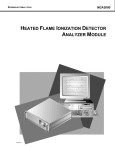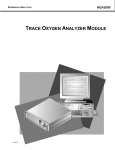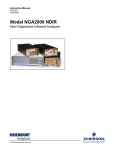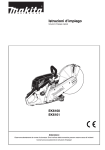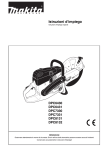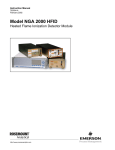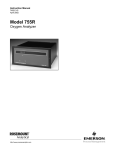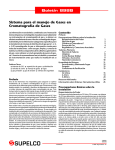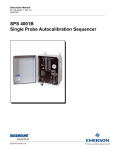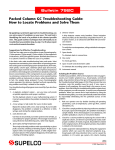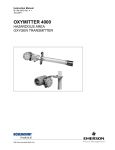Download Emerson NGA2000 TO2 Oxygen Equipment User Manual
Transcript
Instruction Manual 748374-F March 2003 Model NGA2000 TO2 Trace Oxygen Analyzer http://www.processanalytic.com ESSENTIAL INSTRUCTIONS READ THIS PAGE BEFORE PROCEEDING! Rosemount Analytical designs, manufactures and tests its products to meet many national and international standards. Because these instruments are sophisticated technical products, you MUST properly install, use, and maintain them to ensure they continue to operate within their normal specifications. The following instructions MUST be adhered to and integrated into your safety program when installing, using, and maintaining Rosemount Analytical products. Failure to follow the proper instructions may cause any one of the following situations to occur: Loss of life; personal injury; property damage; damage to this instrument; and warranty invalidation. • Read all instructions prior to installing, operating, and servicing the product. • If you do not understand any of the instructions, contact your Rosemount Analytical representative for clarification. • Follow all warnings, cautions, and instructions marked on and supplied with the product. • Inform and educate your personnel in the proper installation, operation, and maintenance of the product. • Install your equipment as specified in the Installation Instructions of the appropriate Instruction Manual and per applicable local and national codes. Connect all products to the proper electrical and pressure sources. • To ensure proper performance, use qualified personnel to install, operate, update, program, and maintain the product. • When replacement parts are required, ensure that qualified people use replacement parts specified by Rosemount. Unauthorized parts and procedures can affect the product’s performance, place the safe operation of your process at risk, and VOID YOUR WARRANTY. Look-alike substitutions may result in fire, electrical hazards, or improper operation. • Ensure that all equipment doors are closed and protective covers are in place, except when maintenance is being performed by qualified persons, to prevent electrical shock and personal injury. The information contained in this document is subject to change without notice. Teflon® is a registered trademark of E.I. duPont de Nemours and Co., Inc. SNOOP® is a registered trademark of NUPRO Co. Waferpure™ is a trademark of Millipore Corp. Nanochem® is a registered trademark of Semigas Corp. Emerson Process Management Rosemount Analytical Inc. Process Analytic Division 1201 N. Main St. Orrville, OH 44667-0901 T (330) 682-9010 F (330) 684-4434 e-mail: [email protected] http://www.processanalytic.com Instruction Manual Model NGA2000 TO2 748374-F March 2003 TABLE OF CONTENTS PREFACE...........................................................................................................................................P-1 Intended Use Statement.....................................................................................................................P-1 Definitions ...........................................................................................................................................P-1 Safety Summary .................................................................................................................................P-2 Authorized Personnel .........................................................................................................................P-2 General Precautions For Handling And Storing High Pressure Gas Cylinders .................................P-4 Documentation....................................................................................................................................P-5 Compliances .......................................................................................................................................P-5 Glossary Of Terms ...........................................................................................................................P-6 1-0 1-1 1-2 1-3 1-4 1-5 DESCRIPTION AND SPECIFICATIONS..............................................................................1-1 Overview................................................................................................................................1-1 Typical Applications...............................................................................................................1-1 Theory Of Technology ...........................................................................................................1-1 Features.................................................................................................................................1-1 Specifications.........................................................................................................................1-4 a. General ...........................................................................................................................1-4 b. Sample ............................................................................................................................1-4 c. Physical...........................................................................................................................1-4 d. Gas Connections.............................................................................................................1-4 2-0 2-1 2-2 INSTALLATION ....................................................................................................................2-1 Unpacking..............................................................................................................................2-1 Assembly ...............................................................................................................................2-1 a. Electrolyte Addition .........................................................................................................2-1 Location .................................................................................................................................2-1 Gases ....................................................................................................................................2-1 a. Requirements..................................................................................................................2-1 b. Connections ....................................................................................................................2-2 c. Leak Test ........................................................................................................................2-4 Electrical Connections ...........................................................................................................2-5 2-3 2-4 2-5 3-0 3-1 3-2 3-3 3-4 3-5 3-6 3-7 3-8 STARTUP AND OPERATION ............................................................................................3-1 Overview................................................................................................................................3-1 Displays .................................................................................................................................3-1 a. Run Mode Display...........................................................................................................3-1 b. Menu Displays.................................................................................................................3-1 c. Help Displays ..................................................................................................................3-2 Startup Procedure .................................................................................................................3-3 Quick Start Feature ...............................................................................................................3-3 Gas Scale Factor (GSF) ........................................................................................................3-3 Calibration..............................................................................................................................3-3 Routine Operation .................................................................................................................3-4 Alarm indication .....................................................................................................................3-5 Rosemount Analytical Inc. A Division of Emerson Process Management Contents i Instruction Manual 748374-F March 2003 4-0 4-1 Model NGA2000 TO2 4-2 4-3 4-4 4-5 4-6 4-7 MAINTENANCE AND TROUBLESHOOTING .....................................................................4-1 Overview................................................................................................................................4-1 a. Water Addition.................................................................................................................4-2 Fuses .....................................................................................................................................4-2 Electrolyte Replacement........................................................................................................4-2 Sensor Replacement .............................................................................................................4-2 Flow Sensor Replacement ....................................................................................................4-3 Printed Circuit Boards............................................................................................................4-3 Troubleshooting.....................................................................................................................4-3 5-0 5-1 5-2 REPLACEMENT PARTS ......................................................................................................5-1 Matrix .....................................................................................................................................5-1 Replacement Parts ................................................................................................................5-1 6-0 6-1 6-2 6-3 RETURN OF MATERIAL ....................................................................................................6-1 Return Of Material .................................................................................................................6-1 Customer Service ..................................................................................................................6-1 Training..................................................................................................................................6-1 7-0 7-1 7-2 APPENDIX A. MENU STRUCTURE....................................................................................7-1 NGA TO2 Menu Structure Introduction .................................................................................7-1 NGA TO2 Analyzer Module Menus .......................................................................................7-1 8-0 APPENDIX B. USER INTERFACE HELP ...........................................................................8-1 9-0 INDEX....................................................................................................................................9-1 748377 MATERIAL SAFETY DATA SHEET ii Contents Rosemount Analytical Inc. A Division of Emerson Process Management Instruction Manual 748374-F March 2003 Model NGA2000 TO2 LIST OF ILLUSTRATIONS Figure 1-1. Figure 1-2. Figure 2-1. Figure 2-2. Figure 2-3. Figure 2-4. Figure 3-1. Figure 3-2. Figure 3-3. Figure 3-4. Figure 3-5. Figure 3-6. Figure 4-1. Figure 4-2. Trace Oxygen Detector Technology...................................................................... 1-2 Trace Oxygen Analyzer Module – Top View ......................................................... 1-3 Analyzer Module Interconnection with Instrument Platform .................................. 2-2 Trace Oxygen Analyzer Outline and Mounting Dimensions.................................. 2-3 Trace Oxygen Analyzer Back Panel Connections................................................. 2-4 Trace Oxygen Analyzer Front Panel ..................................................................... 2-5 Run Mode Display ................................................................................................. 3-1 Main Menu ............................................................................................................. 3-1 Basic Controls Menu.............................................................................................. 3-2 Expert Controls Menu ............................................................................................ 3-2 Analyzer Module Set-up Menu .............................................................................. 3-2 Typical Help Menu (shown is Zero/Span Calibration Help)................................... 3-2 Trace Oxygen Analyzer Sensor Assembly ............................................................ 4-1 Load Factory Calibration Data Menu..................................................................... 4-3 LIST OF TABLES Table 3-1. Rosemount Analytical Inc. Trace Oxygen Analyzer Module Alarms ................................................................ 3-5 A Division of Emerson Process Management Contents iii Instruction Manual 748374-F March 2003 iv Contents Model NGA2000 TO2 Rosemount Analytical Inc. A Division of Emerson Process Management Instruction Manual 748374-F March 2003 Model NGA2000 TO2 PREFACE INTENDED USE STATEMENT The purpose of this manual is to provide information concerning the components, functions, installation and maintenance of the Model NGA2000 TO2 and the System Accessories of the NGA2000 System. Some sections may describe equipment not used in your configuration. The user should become thoroughly familiar with the operation of this module before operating it. Read this instruction manual completely. DEFINITIONS The following definitions apply to DANGERS, WARNINGS, CAUTIONS and NOTES found throughout this publication. DANGER . Highlights the presence of a hazard which will cause severe personal injury, death, or substantial property damage if the warning is ignored. WARNING . Highlights an operation or maintenance procedure, practice, condition, statement, etc. If not strictly observed, could result in injury, death, or long-term health hazards of personnel. CAUTION. Highlights an operation or maintenance procedure, practice, condition, statement, etc. If not strictly observed, could result in damage to or destruction of equipment, or loss of effectiveness. NOTE Highlights an essential operating procedure, condition or statement. Rosemount Analytical Inc. A Division of Emerson Process Management Preface P-1 Instruction Manual 748374-F March 2003 Model NGA2000 TO2 SAFETY SUMMARY If this equipment is used in a manner not specified in these instructions, protective systems may be impaired. AUTHORIZED PERSONNEL To avoid explosion, loss of life, personal injury and damage to this equipment and on-site property, all personnel authorized to install, operate and service the this equipment should be thoroughly familiar with and strictly follow the instructions in this manual. SAVE THESE INSTRUCTIONS. WARNING PARTS INTEGRITY Tampering with or unauthorized substitution of components may adversely affect safety of this product. Use only factory-approved components for repair. WARNING . PRESSURIZED GAS This module requires periodic use of pressurized gas. See General Precautions For Handling And Storing High Pressure Gas Cylinders on page P-4. WARNING. CAUSTIC LIQUID Electrolyte is a caustic solution. Review the Material Safety Data Sheet in the rear of this manual. WARNING. POSSIBLE EXPLOSION HAZARD This equipment is not designed and should not be used in the analysis of flammable samples. Use of this equipment in this way could result in explosion and death. P-2 Preface Rosemount Analytical Inc. A Division of Emerson Process Management Instruction Manual 748374-F March 2003 Model NGA2000 TO2 NOTICE Software compatibility is necessary for all NGA2000 components in your system to work together. The version of your Platform's software must be equal to or greater that the version of any other module(s) for successful compatibility. If it is not, contact Rosemount Analytical at 800-441-7245 to order software upgrade kit PN 657150 for the Platform. You can locate the version of each NGA2000 component as follows: Platform Controller Board Turn power ON. The display will show "Control Module V2. ...". This is the software version. Analyzer Module Located on the right side of the Analyzer Module case. I/O Module Located on the backplane connector of the module. If no label is present, the module is Version 2.0. Rosemount Analytical Inc. A Division of Emerson Process Management Preface P-3 Instruction Manual 748374-F March 2003 Model NGA2000 TO2 GENERAL PRECAUTIONS FOR HANDLING AND STORING HIGH PRESSURE GAS CYLINDERS Edited from selected paragraphs of the Compressed Gas Association's "Handbook of Compressed Gases" published in 1981 Compressed Gas Association 1235 Jefferson Davis Highway Arlington, Virginia 22202 Used by Permission 1. Never drop cylinders or permit them to strike each other violently. 2. Cylinders may be stored in the open, but in such cases, should be protected against extremes of weather and, to prevent rusting, from the dampness of the ground. Cylinders should be stored in the shade when located in areas where extreme temperatures are prevalent. 3. The valve protection cap should be left on each cylinder until it has been secured against a wall or bench, or placed in a cylinder stand, and is ready to be used. 4. Avoid dragging, rolling, or sliding cylinders, even for a short distance; they should be moved by using a suitable hand-truck. 5. Never tamper with safety devices in valves or cylinders. 6. Do not store full and empty cylinders together. Serious suckback can occur when an empty cylinder is attached to a pressurized system. 7. No part of cylinder should be subjected to a temperature higher than 125°F (52°C). A flame should never be permitted to come in contact with any part of a compressed gas cylinder. 8. Do not place cylinders where they may become part of an electric circuit. When electric arc welding, precautions must be taken to prevent striking an arc against the cylinder. P-4 Preface Rosemount Analytical Inc. A Division of Emerson Process Management Instruction Manual 748374-F March 2003 Model NGA2000 TO2 DOCUMENTATION The following NGA2000 Trace Oxygen Analyzer Module instruction materials are available. Contact Customer Service Center (page 6-1). 748374 Instruction Manual (this document) COMPLIANCES This product may carry approvals from several certifying agencies for use in non-hazardous, indoor locations. If so, the product will carry approval insignia on the product name-rating plate. ® NRTL/C Rosemount Analytical Inc. has satisfied all obligations from the European Legislation to harmonize the product requirements in Europe. These products comply with the standard level of NAMUR EMC. Recommendation (May 1993). NAMUR This product satisfies all obligations of all relevant standards of the EMC framework in Australia and New Zealand. N96 Rosemount Analytical Inc. A Division of Emerson Process Management Preface P-5 Instruction Manual 748374-F March 2003 Model NGA2000 TO2 GLOSSARY OF TERMS Analyzer Module The module that contains all sensor/detector components for development of a Primary Variable signal; includes all signal conditioning and temperature control circuitry. Backplane The interconnect circuit board which the Controller Board, Power Supply, Analyzer Module power and network cables, I/O Modules and Expansion Modules plug into. Control Module The Operator Interface plus the Controller Board. Controller Board The computer board that serves as the Network Manager and operates the Display and Keypad. Distribution Assembly The Backplane and the card cages that hold I/O and Expansion Modules. Expansion Module A circuit board that plugs into the Backplane from the front of the Platform and performs special features not related to I/O functions. I/O Module A circuit board that plugs into the Backplane from the rear of the Platform. Has a connector terminal for communication with external data acquisition devices and provides an input/output function. Operator Interface The Display and Keyboard. Platform Any workable collection of the following: Controller Board, Power Supply, Distribution Assembly, Enclosure and Operator Interface. Power Supply Any of a variety of components that provides conditioned power to other NGA2000 components, from the Power Supply Board that plugs into the front of the Backplane in a stand-alone instrument to several larger ones that can power larger collections of modules and components. Primary Variable The measured species concentration value from an Analyzer Module. Secondary Variable Data placed on the network by a module regarding current status, e.g., sample flow, source voltage and other diagnostic information. System Any collection of Analyzer Module(s), Platform (s), I/O Module(s) and Expansion Module(s) P-6 Preface Rosemount Analytical Inc. A Division of Emerson Process Management Instruction Manual 748374-F March 2003 Model NGA2000 TO2 SECTION 1 DESCRIPTION AND SPECIFICATIONS 1-1 OVERVIEW This manual describes the Trace Oxygen (TO2) Analyzer Module of Rosemount Analytical's NGA2000 Series of gas analysis components. The TO2 Analyzer Module is designed to continuously determine the concentration of trace oxygen in a flowing gaseous mixture. The concentration is expressed in parts-per-million. based on the fact that oxygen in the sample is reduced by an electrochemical reaction. This reduction occurs at the cathode and results in the generation of hydroxyl ions. These hydroxyl ions migrate to the anode where they are oxidized to reform oxygen. The oxidation reaction generates four electrons which in turn migrate to the anode to participate in the reduction reaction: (Cathode Reaction) The TO2 Analyzer Module is configured as a shelf-mount module, designed to be installed external from the platform on an associated shelf capable of holding two modules side-byside, with gas connections made from the rear. All electronics relative to sample detection and conditioning are included in this module. 1-2 TYPICAL APPLICATIONS The TO2 Analyzer Module has specific applications in the following areas: • Trace oxygen in product nitrogen and argon streams from air separation plants • Trace oxygen in inerting atmospheres for heat treat furnaces • Trace oxygen in glove-box applications O2 + 2 H2O + 4 e- → 4 OH(Anode Reaction) 4 OH- → O2 + 2 H2O + 4 eA polarizing voltage of approximately 1.3 VDC is applied between the anode and cathode to drive the oxidation and reduction reactions. The resulting current flow produced by the flow of electrons is directly proportional to the oxygen content in the sample gas. 1-4 FEATURES Among the features included in the TO2 Analyzer Module are: • Quick start feature • Electrolyte level alarm 1-3 THEORY OF TECHNOLOGY The TO2 Analyzer Module uses the coulometric principle of oxygen detection. This technology is Rosemount Analytical Inc. A Division of Emerson Process Management • High oxygen protection circuit with alarm • Sample flow indication. Description and Specifications 1-1 Instruction Manual 748374-F March 2003 Model NGA2000 TO2 SECONDARY ANODE (+) BI-STRATA™ DIFFUSION BARRIER e- ELECTRONICS S SAMPLE IN KOH O2 - OH O2 SAMPLE OUT S eO2 SENSING CATHODE (-) SECONDARY CATHODE (-) O2 SENSING ANODE (-) Figure 1-1. Trace Oxygen Detector Technology 1-2 Description and Specifications Rosemount Analytical Inc. A Division of Emerson Process Management Instruction Manual 748374-F March 2003 Model NGA2000 TO2 Sensor Assembly Network/Power Module Sensor Computer Board Sample Flow Sensor Power Board Figure 1-2. Trace Oxygen Analyzer Module – Top View Rosemount Analytical Inc. A Division of Emerson Process Management Description and Specifications 1-3 Instruction Manual 748374-F March 2003 Model NGA2000 TO2 1-5 SPECIFICATIONS a. General Measurement Species................... Trace Oxygen Ranges .......................................... 0 to 100 ppm (output scalable down to 0-2 ppm fullscale) Accuracy........................................ ±3% of reading or ±0.02% of range (except for ranges ≤ 100 ppm: ±3% of reading or ±0.05% of range) Sensitivity ...................................... <10 ppb Oxygen Noise ............................................. 1% of fullscale, peak to peak Linearity ......................................... ±1% of fullscale Response Time ............................. Typically 90% in less than 20 seconds Zero Drift........................................ ≤±1% of fullscale/24 hours at constant temperature Span Drift....................................... ≤±1% of fullscale/24 hours at constant temperature Effect of Temperature.................... 0.32% of reading per °F from 70°F (0.58% of reading per °C from 21°C) Effect of Flow................................. ≤2% of reading for a flow change of ±250 cc/min (0.5 SCFH) Operating Temperature ................. 32°F to 113°F (0°C to 45°C) Power Requirements..................... +24 VDC ±5%, 10 W max. Ripple and Noise: <100 mV peak to peak Line and Load Regulations: <±1% b. Sample Sample .......................................... Non-flammable (below 100% of the LEL) Flow Rate ...................................... 0.5 to 1.5 L/min. Supply Pressure ............................ 1027 to 1082 hPa - absolute (0.2 to 1.0 psig) Temperature .................................. 32°F to 113°F (0°C to 45°C) Particulates.................................... filtered to <0.1 mg/L; non-condensing at ambient temperature Sample Humidity ........................... non-condensing at ambient temperatures c. Physical Materials in contact with sample ... Stainless steel, Teflon, Delrin, neoprene Dimensions.................................... See Figure 2-2.Trace Oxygen Analyzer Outline and Mounting Dimensions on page 2-3 Weight ........................................... 6.8 kg (15 lbs.) Mounting........................................ Horizontal, external to Platform or custom installed in a panel Case Classification........................ General Purpose for installation in weather protected area Max. Separation from Platform...... 1600 m (1 mile) d. Gas Connections Sample In ...................................... 1/4 inch O.D. tube fitting Sample Out.................................... 1/4 inch O.D. tube fitting See the Preface Section of the Platform manual for specifications regarding Platform related components. 1-4 Description and Specifications Rosemount Analytical Inc. A Division of Emerson Process Management Instruction Manual 748374-F March 2003 Model NGA2000 TO2 SECTION 2 INSTALLATION proximately 15 minutes and check for leaks around the base of the reservoir, and at the seams and corners. If a leak is found, contact the factory before proceeding. Drain the Sensor. 2-1 UNPACKING If the Trace Oxygen (TO2) Analyzer Module is received as a separate unit, carefully examine the shipping carton and contents for signs of damage. Immediately notify the shipping carrier if the carton or contents is damaged. Retain the carton and packing material until all components associated with the TO2 Analyzer Module are operational. Fill the Sensor with one bottle of electrolyte supplied with the analyzer module. Use the entire contents of the bottle. NOTE: 2-2 ASSEMBLY Do not add water. The volume and concentration of the bottled electrolyte is pre-measured. Before installation of the TO2 Analyzer Module, electrolyte must be added to the Sensor. Follow the procedure described below under Section 22a below. After addition of electrolyte, locate the analyzer module on an appropriate mounting surface and connect the network cable to either the NETWORK 1 or NETWORK 2 connection on the Analyzer Module, and the NETWORK connection on the Platform network I/O port. (See Figure 2-1 on page 2-2 and Figure 2-4 on page 2-5.) a. Electrolyte Addition Before adding electrolyte to the Sensor, it is recommended to check the Sensor for possible leakage caused by damage in shipment. To check the Sensor for leakage, remove the top cover of the Analyzer Module and locate and remove the 5 mounting screws which hold the Sensor Assembly (Sensor, flow meter, plumbing, inlet/outlet fittings) to the module (see Figure 4-1 on page 4-1). Be careful not to lose these screws as they have metric threads. Carefully lift out the Sensor assembly and remove from the analyzer module. Place on a flat surface and remove the black Sensor cover by unscrewing counterclockwise. Add distilled or deionized water to the Sensor to the maximum level indication on the Sensor reservoir. Let Sensor stand for ap- Rosemount Analytical Inc. A Division of Emerson Process Management Reinstall the black Sensor cover and carefully reinstall the Sensor Assembly inside the Analyzer Module. Do not the tilt the Sensor Assembly excessively as electrolyte may leak out. 2-3 LOCATION (See Figure 2-2 on page 2-3) The TO2 Analyzer Module comes standard with mounting ears for easy installation on flat, horizontal surfaces. , Install the TO2 Analyzer Module in a clean, weather-proofed, vibration-free location free from extreme temperature variations and moisture. For best results, install the instrument near the sample stream to minimize sample transport time. , Operating ambient temperature is 0 °C to 45 °C (32 °F to 81 °F). Temperature change should not exceed 10 °C (18 °F) per hour. The same temperature restrictions apply to the location of the zero and span gas cylinders. 2-4 GASES a. Requirements The TO2 Analyzer Module requires only a standard of accurately known composition for use as a span gas. The span gas should be supplied from a cylinder equipped Installation 2-1 Instruction Manual 748374-F March 2003 Model NGA2000 TO2 with a clean, metallic diaphragm, two-stage regulator. A shutoff valve is recommended. Pressure Constant between 13.8 and 69 hPa - gauge (0.2 and 1.0 psig) sample inlet pressure is recommended. If a needle valve is used upstream of the Analyzer Module to control flow, the inlet pressure to the needle valve should not exceed 345 hPa (5 psig). A constant sample flow rate between 1.0 to 3.0 SCFH (0.5 to 1.5 l/min) is recommended for best results. The Analyzer Module must vent to atmosphere to avoid back pressure influences on the oxygen reading. Calibration Gases The TO2 module does not require routine zero calibration. The zero is factory set and does not experience routine drift. Over long periods of time, the zero may experience minor drift. For low ppm range analyzers, you may wish to check the zero at one year intervals. Oxygen-free nitrogen is recommended for use as zero gas. This gas is certified to <0.5 ppm oxygen and can be improved by passing the zero gas through an oxygen scrubber such as Millipore™ Waferpure or Semigas Nanochem® resin purifiers. A mixture of trace oxygen in a background of nitrogen is recommended as span gas. For maximum accuracy, the concentration of trace oxygen in the span gas should be as high as possible for the range of measurement. b. Connections (See Figure 2-3 on page 2-4 ) Connect inlet and outlet lines for sample to appropriately labeled fittings on the rear panel. SAMPLE IN and SAMPLE OUT are 1/4-inch ferruletype compression fittings. Zero and span gases should be introduced at the SAMPLE IN fitting at normal sample inlet flow rate. Sample Metallic tubing is recommended for the sample line. The use of plastic, Teflon, or other non-metallic tubing can result in ambient oxygen permeation through the tubing causing higher than expected reading. Exhaust tubing should be 1/4 inch (6.3 mm) or larger, and can be metallic or non-metallic. The sample must be clean and dry before entering the Analyzer Module. Sample should be filtered for particulates down to two microns, and should have a dewpoint at least 5 °C (13 °F) below the coldest expected ambient temperature. ANALYZER MODULE CONNECTIONS BACKPLANE CONNECTIONS Network 1 Backplane Network 2 Power Controller Board Connector Fuse Network Power Indicator Light Power Figure 2-1. Analyzer Module Interconnection with Instrument Platform 2-2 Installation Rosemount Analytical Inc. A Division of Emerson Process Management Instruction Manual 748374-F March 2003 Model NGA2000 TO2 .23 [6] 7.75 [197] 7.75 [197] 1.61 [41] .23 [6] 5.78 [147] .266 DIA [6.75] 18.56 [471] 12.00 [305] 11.00 [279] 6.00 [152] 7.00 [178] 8.25 [206] 8.10 [206] 10.15 [258] 2.70 [68] 6.62 [168] 1.2 [31] .06 [1.5] 1.2 [31] Figure 2-2. Trace Oxygen Analyzer Outline and Mounting Dimensions Rosemount Analytical Inc. A Division of Emerson Process Management Installation 2-3 Instruction Manual 748374-F March 2003 Model NGA2000 TO2 Sample Inlet 1/4" Tube Sample Exhaust 1/4" Tube Figure 2-3. Trace Oxygen Analyzer Back Panel Connections CAUTION GAS OVERPRESSURE At no time should sample, zero or span gas inlet pressure exceed 69 hPa - gauge (1.0 psig). Damage to the Sensor may occur if this pressure level is exceeded. c. LEAK TEST The TO2 Analyzer Module is completely tested at the factory for gas leakage. The user is responsible for testing for leakage only at the inlet and outlet fittings on the rear panel. Caution: Do not expose the Sensor to pressure in excess of 1.0 psig as this may cause damage. CAUTION SAMPLE FLOW Do not test the sample pressure by blocking the exhaust. When the pressure is released the sudden surge of flow will spin the internal flowmeter off its bearings and destroy it. 2-4 Installation Rosemount Analytical Inc. A Division of Emerson Process Management Instruction Manual 748374-F March 2003 Model NGA2000 TO2 Network Connections Power Connection Fuse Power Indicator Light Figure 2-4. Trace Oxygen Analyzer Front Panel 2-5 ELECTRICAL CONNECTIONS NOTE Electrical connnections must be made in compliance with National Electrical Code (ANSI/NFPA 70) and/or any applicable national or electical codes. Two electrical connections are required on the Analyzer Module: POWER and NETWORK (See Figure 2-4 above). On the Analyzer Module, two NETWORK connectors are available, Rosemount Analytical Inc. A Division of Emerson Process Management either of which is appropriate for: 1) interconnection with the Backplane of the Platform or 2) "daisy-chaining" with other NGA2000 components (A star connection is acceptable for LON lengths under about 10 meters.) Connect a source of 24 V 5A DC power to the power inlet. Make sure that the ground connection is made, and that this is separate from the power return lead. Failure to ensure a good ground may result in random noise and disturbance in the analyzer readings. Installation 2-5 Instruction Manual 748374-F March 2003 2-6 Installation Model NGA2000 TO2 Rosemount Analytical Inc. A Division of Emerson Process Management Instruction Manual 748374-F March 2003 Model NGA2000 TO2 SECTION 3 STARTUP AND OPERATION 3-1 OVERVIEW Prior to initial startup, the user should perform the leak test procedure outlined in Section 2. For the remainder of this section, Analyzer Module interconnection with a Platform or some interfacing component will be assumed. Display and Keypad information refers to that which the user can expect to see and do with regard to the Front Panel of the Platform. TO2 1 ppm O 2 19.4 0 Range 3 50 Sensor current: 1.4403 mA Sensor temperature: 26.3 C Temperature current: Sample Flow: DISPLAY 2.01 mA 511 ml/min PARMS. (For a complete description of Platform Front Panel controls and indicators, see the Platform instruction manual. MENU NEXT INFO Figure 3-1. Run Mode Display b. Menu Displays 3-2 DISPLAYS Three kinds of Display screens are available to the user: • Run Mode The Menu structure enables the user to access data and functions, and put information onto the network. From the Run Mode display, press the MENUS softkey to gain access to the Main Menu. • Menu Main Menu • Help a. Basic controls . . . Run Mode Display The Run Mode is the normal mode of operation. In this mode, the Display will show the current gas measurement, the component of interest, the current operations of the softkeys, and several graphics: a bar representing the displayed concentration as a percent of fullscale and up to four lines showing user selectable secondary parameters from either the Analyzer Module or any IO module bound to it. See the Platform manual for information as to how to select these. If more than one Analyzer Module is connected to the system, an additional Run Mode display will show as many as four (five for version 2.3 and later) gas measurements on screen. Rosemount Analytical Inc. A Division of Emerson Process Management Expert controls and set up . . . (Operational configuration) Technical level configuration . . . (Diagnostic and manufacturing/service) DISPLAY PARMS. NEXT EXT LOCK INFO Figure 3-2. Main Menu The Main Menu is subdivided into three levels of control based generally on which personnel is likely to use it: Basic Controls Operators, Expert Controls and set up System Engineers, and Technical level configuration - Analyzer technicians. Many layers of the menu structure are described at appropriate places throughout this manual. Startup and Operation 3-1 Instruction Manual 748374-F March 2003 Model NGA2000 TO2 The analyzer range settings may be configured through the Analyzer Module set up menu, under Expert controls and set up. From the Run Mode display, press the MENUS softkey to gain access to the Main Menu. The Basic controls menu is as follows: Analyzer module set up Range settings . . . Basic Controls Measurement range number: Range upper limit: Range and functional control: CURRENTRNGHI CONTROL Displayed parameters . . . Analyzer tag: Sleep Mode: Exit Sleep Mode! Initiate Quick Start! Quick Start: HOME HOME ESCAPE INFO TAG ESCAPE INFO Figure 3-5. Analyzer Module Set-up Menu Figure 3-3. Basic Controls Menu c. This menu allows the user to view the current range’s upper limit, Sleep mode, and quick start status. It also allows quick start initiation or exit from sleep mode. The Help structure is intended to be an online "tutorial," context-sensitive and topicinterconnected, so that the user can practically operate NGA2000 without the need of an instruction manual. In the figure above, the words in italics are the names of the network variables whose values are in fact shown on the screen. The Expert controls menu is as follows: Expert controls Measurement range number: Range lower limit: Range upper limit: Range and functional control: CURRENTRNGHI CONTROL A typical help menu: Zero/Span calibration help This allows manual control of the zero and span. Flow zero gas, and make sure the zero gas value is right; Press the zero key to make the analyzer zero. Or select Factors and individually adjust the reading on each range. In this way you can make the analyzer read what you want. Do the same with span gas. If the zero was not a real zero, the span action will change the zero reading> Set cal gas values in the Calibration gas list screen. HOME HOME ESCAPE INFO Figure 3-4. Expert Controls Menu Help Displays ESCAPE CALINFO INFO Figure 3-6. Typical Help Menu (shown is Zero/Span Calibration Help) This is the help screen for the calibration menus. This menu shows the current range number and range limits. 3-2 Startup and Operation Rosemount Analytical Inc. A Division of Emerson Process Management Instruction Manual 748374-F March 2003 Model NGA2000 TO2 3-3 STARTUP PROCEDURE Establish sample or zero gas flow through the analyzer module at a nominal flow rate of 2 SCFH (1 l/min). Allow gas to flow for 15 to 30 seconds before applying power. Apply power to the TO2 Analyzer Module. Upon initial startup, the separate modules, Controller Board and network "self-install." The display shows the progress of the automatic installation routine, together with a button marked RE_INIT. If the initialization hangs up, pressing the RE_INIT button will restart it, but will cause all the binding information to be erased. The Display will then appear as above. For details on binding, please consult the Platform instruction manual. Establish that sample flow rate is within specifications (see Section 1-5 SPECIFICATIONS on page 1-4). Input security codes (see NGA Reference manual), calibrate, and begin routine operation as following subsections indicate. difference, the diffusion change can be compensated in software. The GSF can be entered manually or calculated automatically. Calculation of the GSF requires the user to enter the sample gas composition. In most applications, the GSF is not required. However, some backgrounds exhibit significantly different diffusion characteristics versus nitrogen (such as helium or hydrogen) and the GSF may improve performance. Under the Technical Level Configuration submenu, select Diagnostic menus... and then select Analyzer Module Diagnostics…. In the Analyzer Module Diagnostics sub-menu select Calibration Parameters.... In the Advanced/Expert Calibration sub-menu select Gas Scale Factor.... To use the GSF, enter the volumetric percentages of each component present in the sample gas. To view more background components, press the MORE softkey. The total must add up to 100 or a new factor will not be computed. If you have a background component which is not shown in this menu, please consult the factory for assistance. 3-4 QUICK START FEATURE This analyzer module is equipped with a quick start feature which allows the sensor to begin measuring low ppm oxygen faster. This feature can be used when the analyzer is first turned on to decrease the time required for the sensor to reach equilibrium. This function is most effective for gas sample measurements below 100 ppm. To maintain sensor life, it is recommended that this feature be used no more than two times in any 24 hour period. Under the Basic Controls sub-menu, move the cursor to Initiate quick start! and press the ↵ key. The unit will begin the quick start function immediately. This procedure will last for approximately 45 seconds. The last measured value is held for the duration of the procedure to prevent false reading fluctuations. 3-5 GAS SCALE FACTOR (GSF) The Gas Scale Factor is used to correct for background gases other than nitrogen. When the background of the sample is other than nitrogen, the diffusion rate of oxygen into the sensor changes. By correcting for the background Rosemount Analytical Inc. A Division of Emerson Process Management Once you have entered all the background composition information, move the cursor to Compute new adjusted gas scale factor! and press the ↵ key and the analyzer module will automatically calculate the new gas scale factor. 3-6 CALIBRATION The TO2 analyzer module is fully factory calibrated using certified gas standards prior to shipment. If the analyzer is operated within its specified operating conditions, no calibration is required. The zero calibration is very stable and does not require checking more than once a year. Depending upon the nature of your application, it may be beneficial to verify the span calibration of the analyzer module every 3-4 months. The following procedure illustrates how to initiate a zero/span calibration. Under the Expert Controls sub-menu select Expert Analyzer Controls and Measurement…, set the Range Number to the range that will be used during sample analysis. Return to the Main Menu by pressing the HOME softkey. Startup and Operation 3-3 Instruction Manual 748374-F March 2003 Model NGA2000 TO2 Introduce zero gas into the SAMPLE INLET, and, after a stable reading is reached, do the following: 1. Move the cursor to Technical Level Configuration... and enter. Select Diagnostic Menus…, then Analyzer Module Diagnostics…, and then Calibration parameters... and enter. 2. Select the User zero calibration... to enter the User zero calibration menu. NOTE: Before proceeding any further, be sure that the zero value is stable and valid. The zero may take 24 hours or longer to achieve stable zero for the low ranges. 11. If for any reason you want to restore the original factory calibration data, you can do so from the Advanced/Expert calibration sub-menu (see step 9 above for directions to this sub-menu). Select Restore factory calibration! and the original values will be restored. NOTE: 3. Move the cursor to the Press the select key for user zero calibration now! Do not alter data in the Load factory calibration data... sub-menu except when replacing sensors. Any changes made to this submenu will become the new default restore factory calibration! values. 4. Press the ↵ key. The new zero calibration will now be entered. 12. Press the HOME softkey to re-enter the Main Menu. 5. Press the ← key to return to the previous menu. 13. Press DISPLAY softkey for the Run Mode display. 6. Introduce a suitable span gas into the SAMPLE INLET and allow reading to stabilize. Move the cursor to the User span calibration... line and press the ↵ key. If you are unable to calibrate the module for some reason, see the NGA Reference manual for a list of possible causes and solutions. The most likely cause is the use of incorrect span gases. 7. Move the cursor to the Span gas concentration: line and press the ↵ key. Enter the correct span gas value by using the ↑↓ keys to change value and the ←→ keys to select position. Press the ↵ key to enter the new span gas value. 8. Move the cursor to the Press the select key for user span calibration now! and press the ↵ key. The new span calibration will now be entered. 3-4 set up... From the Analyzer module set up sub-menu select Calibration... and from the Advanced/Expert calibration sub-menu select Calibration data display... This screen is a view only display and data cannot be edited from this screen. 3-7 ROUTINE OPERATION The TO2 Analyzer Module is designed to analyze the sample stream continuously. Normally, it is never powered off except for servicing or for a prolonged shutdown. 9. Press the ← arrow key to return to the previous menu. Maximum permissible interval between calibration checks depends on the analytical accuracy required, and therefore cannot be specified. Initially, the instrument should be checked at least once every 3-4 months. This practice should continue until experience indicates that some other interval is more appropriate. 10. You can view the new calibration data in the Calibration data display screen. To access this screen go to the Expert controls and set up sub-menu and select Analyzer module For details as to the general operation of the NGA analyzer module software, and the use of IO modules with the TO2 module, see the Platform Components manual. Startup and Operation Rosemount Analytical Inc. A Division of Emerson Process Management Instruction Manual Model NGA2000 TO2 748374-F March 2003 3-8 ALARM INDICATION NGA analyzer modules continuously monitor a number of internal parameters. It is possible to make the analyzer generate certain kinds of alarm indications if these parameters' values exceed or reduce below specified levels. The general alarm variable will have its value changed if an alarm occurs. See the NGA Reference manual for further details. DESCRIPTION Low Electrolyte Low Sample Flow Sleep Mode Low Sensor Temperature High Sensor Temperature Software Error Table 3-1. TYPE WARNING WARNING WARNING WARNING WARNING FAILURE Trace Oxygen Analyzer Module Alarms Rosemount Analytical Inc. A Division of Emerson Process Management Startup and Operation 3-5 Instruction Manual 748374-F March 2003 3-6 Startup and Operation Model NGA2000 TO2 Rosemount Analytical Inc. A Division of Emerson Process Management Instruction Manual 748374-F March 2003 Model NGA2000 TO2 SECTION 4 MAINTENANCE AND TROUBLESHOOTING 4-1 OVERVIEW CAUTION QUALIFIED PERSONNEL This equipment should not be adjusted or repaired by anyone except properly qualified service personnel. The sensor is designed to hold at least 100 cc of electrolyte. Typically, bone dry sample gas can extract approximately 5-10 cc of water per month from the sensor. It is recommended to check the electrolyte level every 3-4 months to assure that the electrolyte level is within the acceptable operating limits as indicated by the label on the reservoir section of the sensor. The TO2 analyzer module is equipped with a low electrolyte alarm which indicates when replenishment of the sensor is required. Please refer to the Platform manual for details on configuring alarms. WARNING PARTS INTEGRITY Tampering with or unauthorized substitution of components may adversely affect safety of this product. Use only factory-approved components for repair. The TO2 Analyzer Module requires very little maintenance during normal operation. CAUTION REFILLING SENSOR When refilling the sensor, only use distilled or deionized water. Do not use electrolyte or tap water as they can cause damage to the sensor. Take care not to overfill. The sensor in the TO2 utilizes a liquid electrolyte. When measuring dry gases, it may be necessary to replenish the liquid by adding distilled or deionized water. Sensor Cover TOP VIEW Indicator, Electrolyte Level Enclosure Back Wall Sensor Reservoir Mounting Screws (2 places) SIDE VIEW Mounting Screws (3 places) Flow Sensor Figure 4-1. Trace Oxygen Analyzer Sensor Assembly Rosemount Analytical Inc. A Division of Emerson Process Management Maintenance and Troubleshooting 4-1 Instruction Manual 748374-F March 2003 a. Water Addition To add water: 1. Remove the top cover of the analyzer module. 2. Unscrew the black sensor cover. 3. Slide the cover back just enough to allow the neck of the fill bottle to fit into the sensor reservoir. 4. Add distilled or deionized water using the fill bottle provided with the analyzer module. Fill to approximately midway between the min and max level indicators on the sensor label. Be careful not to spill water, splash electrolyte or overfill sensor. 5. Replace the sensor cover securely. 6. Replace the top cover of the analyzer module. If the electrolyte alarm is activated but the sensor shows sufficient electrolyte, the electrolyte may have been contaminated by substances present in the sample which are chemically incompatible with the sensor or electrolyte. If this should occur, the electrolyte must be drained and replaced with fresh electrolyte. Refer to Section 4-3 below for the proper procedure for replacing electrolyte. Several other components may require replacement. These are discussed in the following sections. 4-2 FUSES Remove power to the Analyzer Module prior to fuse replacement. To replace the Power Fuse, locate the fuse cover on the front panel of the Analyzer Module, as shown partially in Figure 2-3 on page 2-4. Push and turn the fuseholder cover 1/4 turn counterclockwise. Remove and replace the fuse as required. There are no other fuses in the Analyzer Module. 4-2 Maintenance and Troubleshooting Model NGA2000 TO2 4-3 ELECTROLYTE REPLACEMENT Before replacing the electrolyte, be sure to turn off and disconnect all gas connections to the analyzer module. Turn off or disconnect the power to the analyzer module. To replace the Sensor electrolyte, remove the Analyzer Module from its mounting location and place on a sturdy work surface. Be careful not to tilt the module from its horizontal position as the Sensor contains liquid that can spill. Remove the cover of the Analyzer Module and locate the 5 mounting screws that hold the Sensor Assembly onto the Analyzer Module chassis (see Figure 4-1 on page 4-1). Remove the 5 screws and retain. Do not lose the screws - they have metric threads. Disconnect the Sensor signal connector (J5) and the Flow Sensor connector (J6) from the power board. Remove the complete Sensor Assembly from the Analyzer Module. Remove the black sensor cover and invert the Sensor Assembly over a suitable receptacle. Flush the Sensor twice with deionized water. Dispose of the discarded electrolyte and rinse water in accordance with National, Federal, State and Local regulations. (See MSDS in the rear of this manual.) Refill the Sensor with electrolyte as instructed in Section 2-2a on page 2-1. Reinstall the Sensor Assembly and reconnect J5 and J6 to the power board. 4-4 SENSOR REPLACEMENT If the Sensor cannot be regenerated by the addition of water or the replacement of electrolyte, or if the Sensor shows signs of leakage, it may be necessary to replace the Sensor. To replace the Sensor, remove the Sensor Assembly and remove the electrolyte as described in Section 4-3 above. Reinstall the black sensor cover to catch any residual electrolyte. Invert the Sensor Assembly and locate the four (4) mounting screws which hold the Sensor to the Sensor Assembly mounting plate. Remove and retain the four screws. Rosemount Analytical Inc. A Division of Emerson Process Management Instruction Manual 748374-F March 2003 Model NGA2000 TO2 Install replacement Sensor in reverse order. Check Sensor for leaks and add electrolyte as described in Section 2-2a on page 2-1. Reinstall Sensor Assembly in Analyzer Module and reconnect J5 and J6 to the power board. After installation of new Sensor, it will be necessary to load the new calibration data supplied with the Sensor. Enter the new calibration data by entering the Load Factory Calibration Data menu. You can get to this menu as follows: Main Menu, Technical Level Configuration, Analyzer Module Diagnostics, Calibration Parameters, Load Factory Calibration Data. This menu screen will look as follows: Load factory calibration data Concentration 1: Output 1: Temperature 1: Concentration 2: Output 2: Temperature 2: Concentration 3: Output 3: Temperature 3: HOME ESCAPE MORE Figure 4-2. Load Factory Calibration Data Menu The data is supplied with the new sensor and must be entered exactly as shown on the sensor data sheet. To enter the data for data points 4 & 5 and the sensor model, press the MORE soft key to access the next screen. 4-5 FLOW SENSOR REPLACEMENT See Figure 1-2 on page 1-3 for Flow Sensor location. To replace Flow Sensor, remove all connecting hardware and undo connections to the sample line. The Flow Sensor is mounted to the Sensor Assembly mounting plate by two screws. Be sure to install the new Flow Sensor with the flow indication toward the outlet. To remove any PCB, disconnect the associated cables first. Tag each connector and its location before disconnecting any wiring. This helps in reassembly. The Power board and Computer board are located on a common bracket. 4-7 TROUBLESHOOTING The following provides a short list of common troubleshooting tips. Additional information is contained in the Platform Manual. The TO2 analyzer fails to purge down to ppm levels. Prior to conducting any changes to the system, try running a quick start sequence (see Section 3-4 on page 3-3) to see if the oxygen reading goes lower. If the reading does decrease, the sensor has not been allowed sufficient time to consume the dissolved oxygen in the electrolyte. If the reading continues to read high a leak may exist in the sample lines. The number one problem associated with trace oxygen analyzer installation is the occurrence of leaks in your sample plumbing. If the oxygen reading will not come down to ppm levels or is reading higher than expected, the sample plumbing prior to the instrument may have a leak. A quick check can be conducted by observing the oxygen reading at two different flow levels; 0.5 and 2.0 scfh. If the oxygen reading drops significantly when the flow is increased from 0.5 to 2.0 scfh, this is a good indication that a leak exists. To check for leaks prior to the sensor, disconnect the Analyzer Module and cap the inlet line. Pressurize the inlet line to 5 - 10 psig and check all connections with a soapy solution (SNOOP®) to identify leaks. WARNING SENSOR DAMAGE Do not pressure check the sample line with the sensor connected. Over-pressurization of the sensor can result in damage. 4-6 PRINTED CIRCUIT BOARDS All three printed circuit boards can be replaced, if necessary. Refer to Figure 1-2 on page 1-3 for location of the Power, Network and Computer Boards. Rosemount Analytical Inc. A Division of Emerson Process Management The TO2 analyzer exhibits flow sensitivity. Check to make sure that your vent line is not blocked. If you see a rise in reading with an increase in flow, you may be over-pressurizing the sensor due to a blocked vent. Since the Maintenance and Troubleshooting 4-3 Instruction Manual 748374-F March 2003 Model NGA2000 TO2 sensor is a partial pressure measuring device, an increase in sample pressure will cause an increase in reading. If the reading drops with increased flow, conduct the leak check outlined in the troubleshooting tip above. The TO2 analyzer gives erratic and very insensitive readings. Check to see that the electrolyte level is within the limits indicated on the reservoir. Add distilled water as required. If the level is within limits, the electrolyte may have been contaminated. Refer to Section 4-3 on page 4-2 above for proper procedure to replace electrolyte. If replacement of electrolyte does not improve the performance of the sensor, the sensor may have been damaged due to overpressurization or poisoning. Sensor replacement may be required as described in Section 4-4 on page 4-2. 4-4 Maintenance and Troubleshooting Rosemount Analytical Inc. A Division of Emerson Process Management Instruction Manual 748374-F March 2003 Model NGA2000 TO2 SECTION 5 REPLACEMENT PARTS WARNING PARTS INTEGRITY Tampering with or unauthorized substitution of components may adversely affect safety of this product. Use only factory-approved components for repair. TO2 5-1 MATRIX Each analyzer is configured per the customer sales order. Below is the TO2 sales matrix which lists the various configurations available. To identify the configuration of an analyzer, locate the analyzer name-rating plate. The sales matrix identifier number appears on the analyzer name-rating plate. NGA2000 TO2 TRACE OXYGEN ANALYZER MODULE Code 01 02 03 Software version Current version software v2.4 Software v3.X Software Code A1 B1 X99 CONFIGURATION IDENTIFIER RANGE: 0 - 100 ppm RANGE: 0 - 100 ppm with X-GAS Sensor Special Ranges Code CABLE SELECTION 00 None (utilize mounting ears on analyzer module) A1 Base Plate Assembly TO2 01 A1 B1 (EXAMPLE) 5-2 REPLACEMENT PARTS 658350 Computer Analysis Board 657466 LON/Power Board 658300 Power Supply Board 902931 Sensor, Gas Flow 904675 Sensor, Oxygen 0-100 ppm 904676 Electrolyte Solution 903347 Fuse, Time-Delay 6A 250 VAC Rosemount Analytical Inc. A Division of Emerson Process Management Replacement Parts 5-1 Instruction Manual 748374-F March 2003 5-2 Replacement Parts Model NGA2000 TO2 Rosemount Analytical Inc. A Division of Emerson Process Management Instruction Manual 748374-F March 2003 Model NGA2000 TO2 SECTION 6 RETURN OF MATERIAL 6-1 RETURN OF MATERIAL If factory repair of defective equipment is required, proceed as follows: 1. Secure a return authorization from a Rosemount Analytical Inc. Sales Office or Representative before returning the equipment. Equipment must be returned with complete identification in accordance with Rosemount instructions or it will not be accepted. 2. Rosemount CSC will provide the shipping address for your instrument. 3. In no event will Rosemount be responsible for equipment returned without proper authorization and identification. 4. Carefully pack the defective unit in a sturdy box with sufficient shock absorbing material to ensure no additional damage occurs during shipping. 5. In a cover letter, describe completely: • The symptoms that determined the equipment is faulty. • The environment in which the equipment was operating (housing, weather, vibration, dust, etc.). • Site from where the equipment was removed. • Whether warranty or non-warranty service is expected. • Complete shipping instructions for the return of the equipment. 6. Enclose a cover letter and purchase order and ship the defective equipment according to instructions provided in the Rosemount Return Authorization, prepaid, to the address provided by Rosemount CSC. If warranty service is expected, the defective unit will be carefully inspected and tested at the factory. If the failure was due to the conditions listed in the standard Rosemount warranty, the defective unit will be repaired or replaced at Rosemount’s option, and an operating unit will be returned to the customer in accordance with the shipping instructions furnished in the cover letter. For equipment no longer under warranty, the equipment will be repaired at the factory and returned as directed by the purchase order and shipping instructions. 6-2 CUSTOMER SERVICE For order administration, replacement Parts, application assistance, on-site or factory repair, service or maintenance contract information, contact: Rosemount Analytical Inc. Process Analytical Division Customer Service Center 1-800-433-6076 6-3 TRAINING A comprehensive Factory Training Program of operator and service classes is available. For a copy of the Current Operator and Service Training Schedule contact the Technical Services Department at: Rosemount Analytical Inc. Customer Service Center 1-800-433-6076 Rosemount Analytical Inc. Process Analytical Division Customer Service Center 1-800-433-6076 Rosemount Analytical Inc. A Division of Emerson Process Management Return of Material 6-1 Instruction Manual 748374-F March 2003 6-2 Return of Material Model NGA2000 TO2 Rosemount Analytical Inc. A Division of Emerson Process Management Instruction Manual 748374-F March 2003 Model NGA2000 TO2 SECTION 7 APPENDIX A. MENU STRUCTURE 7-1 NGA TO2 MENU STRUCTURE INTRODUCTION This Appendix contains a listing of the menus belonging to the TO2 Analyzer Module. It also lists the available configuration elements, and where they are to be found. Expert Controls and set up … allows access to the Expert analyzer controls… and Analyzer module set up… sub menus. 7-2 NGA TO2 ANALYZER MODULE MENUS The Expert Controls menu allows range number and functional control selection. It also shows the range upper and lower limits. From the main menu, you can access the three major menu trees. Basic controls…allows access to range number selection and range limit, Quick Start initiation and status, and Sleep Mode status and cancellation. The Analyzer Module Setup menu allows access to the Range settings… and Display parameters… sub menus. Rosemount Analytical Inc. A Division of Emerson Process Management Appendix A. Menu Structure 7-1 Instruction Manual 748374-F March 2003 The Range Settings menu allows configuration of the upper and lower limit of the 4 ranges on the Analyzer Module. The maximum and minimum range limits are shown and adjustment beyond these limits is not allowed. Model NGA2000 TO2 The Analyzer Manufacturing Data screen and Analyzer Module Service History screen are both accessible from the Service menus… sub menu. These screens provide factory set data concerning the configuration of the Analyzer Module. The Displayed parameters are the secondary parameters shown on the Display screen (see figure 3-1). The desired parameters can be selected from this menu. Technical level configuration… provides access to the service and diagnostic menus including calibration, gas scale factor, and sensor factory calibration data. 7-2 Appendix A. Menu Structure Rosemount Analytical Inc. A Division of Emerson Process Management Instruction Manual Model NGA2000 TO2 From the Analyzer Diagnostics menu, all analyzer health diagnostic information can be accessed. Calibration controls are also accessible from this menu. 748374-F March 2003 The Advanced / Expert Calibration menu allows access to user calibration screens, and the factory calibration data screens for viewing and data entry. The Gas Scale Factor menu is also accessed from this menu. It is not recommended to conduct user zero and span calibration functions since the sensor is factory calibrated and does not exhibit detectable degradation of calibration over time. The risk of erroneous calibration due to inaccurate gases is greater than the potential of factory calibration change. The Primary Variable Parameters screen provides details on the sensor, and advises the current status of the sleep mode. If the oxygen concentration exceeds 100 ppm, the sleep mode timer begins counting. At the end of 45 minutes, if the concentration has not dropped below 100 ppm, the Analyzer Module will go into sleep mode to protect the sensor from damage due to high oxygen exposure. Rosemount Analytical Inc. A Division of Emerson Process Management Appendix A. Menu Structure 7-3 Instruction Manual 748374-F March 2003 The Load Factory Calibration screens allow the user to enter the factory calibration data unique to the sensor in the Analyzer Module. If the sensor is replaced, this data must be entered from the data sheet provided with the replacement sensor. Additional data points can be accessed by pressing the MORE softkey. Model NGA2000 TO2 The Gas Scale Factor screens allow the user to enter in information relating to the background gas of the trace oxygen measurement. The total concentration of all entries must add up to 100 or the unit will not compute the new adjusted gas scale factor. Calibration Data Display screens look identical to the Load Factory Calibration screens except they are not editable. The Physical Measurements screen displays sample flow information as well as electrolyte level validity. 7-4 Appendix A. Menu Structure Rosemount Analytical Inc. A Division of Emerson Process Management Instruction Manual Model NGA2000 TO2 748374-F March 2003 Temperature Parameters… selection directs the user to the sensor temperature information. It is recommended that the user not conduct temperature calibration of the sensor in the field. Rosemount Analytical Inc. A Division of Emerson Process Management Appendix A. Menu Structure 7-5 Instruction Manual 748374-F March 2003 7-6 Appendix A. Menu Structure Model NGA2000 TO2 Rosemount Analytical Inc. A Division of Emerson Process Management Instruction Manual 748374-F March 2003 Model NGA2000 TO2 SECTION 8 APPENDIX B. USER INTERFACE HELP This section provides a means of rapidly finding any desired function or configuration factor in the menu system. The NGA menu system is necessarily complex due to the wide variety of configuration possibilities available with the NGA architecture. This section consists of a series of titles describing the function or configuration desired, with a series of menu titles that show the path taken to that function. The menu selections are sometimes abbreviated; Basic Controls is referred to as Basic for example, Expert controls and setup as Expert, and Technical level as well as Technical. Menu Items ITEM Add a service date Alarm enabling Analyzer specific alarms Analyzer diagnostics Analyzer specific controls (remote) Binding Displayed parameters Electrolyte level Exit sleep mode Gas scale factor Initiate quick start Last service date List of detected NGA modules Load factory calibration data Manufacturing data Maximum range Minimum range Power supply voltages Quick start status Rosemount Analytical Inc. PATH Technical - Service menus - Service history Analyzer module history - Add service date! Technical – Listing of all modules – Analog I/O – Select I/O module - Relay status Expert - Auxiliary module setup - Select Analog output module – Alarm conditions Technical - Diagnostic menus - Analyzer module diagnostics Expert - Auxiliary module setup - Select Analog output module – Input line control Technical - System setup – Module Binding Expert - Analyzer module setup - Displayed parameters Technical - Diagnostic menus - Analyzer module diagnostics - Physical measurements Basic Technical - Diagnostic menus - Analyzer module diagnostics - Calibration parameters - Gas scale factor Basic Technical – Service menus – Service history – Analyzer module history Technical - Listing of all modules Technical - Diagnostic menus - Analyzer module diagnostics - Calibration parameters Technical – Service menus - Manufacturing data - Analyzer module data Expert - Analyzer module setup - Range settings Expert - Analyzer module setup - Range settings Technical – Diagnostic menus – Analyzer module diagnostics - Power supply voltages Basic A Division of Emerson Process Management NOTES v 2.3 only v 2.3 only User updated Jumps from there into their diagnostic screens Required when changing sensor Maximum range upper limit Minimum range upper limit Appendix B. User Interface Help 8-1 Instruction Manual 748374-F March 2003 ITEM Range number selection Range lower limits Range upper limits Record service codes Reset system Resolution of main reading Sensor current, temperature Sleep mode status Sleep mode timer Software diagnostics Software revision level Span calibration Tag number Test relay operation View sensor calibration data Zero calibration 8-2 Appendix B. User Interface Help Model NGA2000 TO2 PATH NOTES Basic Expert - Analyzer module setup - Range settings Expert - Analyzer module setup - Range settings Technical - Service menus – Service history Analyzer module history - List notes Technical - System setup – System reset Technical - System setup – Main display configuration - Display resolution Technical - Diagnostics menus - Analyzer module diagnostics - Primary variable parameters Basic Technical - Diagnostics menus - Analyzer module diagnostics - Primary variable parameters Technical - Diagnostic menus - Control module diagnostics Technical - Service menus - Manufacturing data - Control module data Technical - Diagnostic menus - Analyzer module diagnostics - Calibration parameters - User span calibration Technical - Service menus - Manufacturing data - Analyzer module data Technical – Listing of all modules – Analog I/O – Select I/O module - Relay status Technical - Diagnostic menus - Analyzer module diagnostics - Calibration parameters Calibration data display Technical - Diagnostic menus - Analyzer module diagnostics - Calibration parameters - User zero calibration Rosemount Analytical Inc. Highly recommend not to be conducted in the field User editable Highly recommend not to be conducted in the field A Division of Emerson Process Management Instruction Manual 748374-F March 2003 Model NGA2000 TO2 SECTION 9 INDEX 2 F 24 V 5A DC power, 2-5 Flow Sensor, 4-2, 4-3 Flow Sensor connector, 4-2 A alarm electrolyte, 4-1, 4-2 indications, 3-5 Analyzer Module electrical connections, 2-5 general operation of software, 3-4 leak test, 2-4 Applications, 1-1 automatic installation, 3-3 G Gas calibration, 2-2 sample, 2-2 span, 2-1 Gas Scale Factor, 3-3, 7-3, 7-4 GSF (Gas Scale Factor), 3-3 I B background gas, 3-3, 7-4 binding, 3-3 C calibration maximum interval between, 3-4 restore factory data, 3-4 span, 3-3 unable, 3-4 viewing data, 3-4 zero, 3-3 Controller Board, 3-3 L leak check, 4-3 LON, 2-5, 5-2 M measuring dry gases, 4-1 N E electrolyte, 2-1, 4-1, 4-2, 4-3, 7-4, 9-1 alarm, 4-1 leak check, 2-1 level, 4-4 level check, 4-1 replacement, 4-2 replacing, 4-2 sensor capacity, 4-1 Exhaust, 2-2 Rosemount Analytical Inc. installation location, 2-1 mounting, 2-1 operating temperature, 2-1 IO modules, 3-4 A Division of Emerson Process Management NGA Reference manual, 3-3, 3-4, 3-5 O oxygen scrubber, 2-2 P Platform, 1-4, 2-1, 2-2, 2-5, 3-1, 3-3, 3-4, 4-1, 4-3 Power Fuse, 4-2 Index 9-1 Instruction Manual 748374-F March 2003 Model NGA2000 TO2 R Return Authorization, 6-1 T Theory of operation, 1-1 S sample connections, 2-2 flow rate, 2-2 inlet pressure, 2-2 security codes, 3-3 sensor electrolyte, 4-2 life, 3-3 load new calibration data, 4-3 maximum psig, 2-4 signal connector, 4-2 span calibration, 3-3 span gas, 2-1, 2-2, 2-4, 3-4 9-2 Index Z zero calibration, 3-3 zero gas, 2-2, 3-3, 3-4 Rosemount Analytical Inc. A Division of Emerson Process Management WARRANTY Goods and part(s) (excluding consumables) manufactured by Seller are warranted to be free from defects in workmanship and material under normal use and service for a period of twelve (12) months from the date of shipment by Seller. Consumables, glass electrodes, membranes, liquid junctions, electrolyte, o-rings, etc., are warranted to be free from defects in workmanship and material under normal use and service for a period of ninety (90) days from date of shipment by Seller. Goods, part(s) and consumables proven by Seller to be defective in workmanship and/or material shall be replaced or repaired, free of charge, F.O.B. Seller's factory provided that the goods, part(s) or consumables are returned to Seller's designated factory, transportation charges prepaid, within the twelve (12) month period of warranty in the case of goods and part(s), and in the case of consumables, within the ninety (90) day period of warranty. This warranty shall be in effect for replacement or repaired goods, part(s) and the remaining portion of the ninety (90) day warranty in the case of consumables. A defect in goods, part(s) and consumables of the commercial unit shall not operate to condemn such commercial unit when such goods, part(s) and consumables are capable of being renewed, repaired or replaced. The Seller shall not be liable to the Buyer, or to any other person, for the loss or damage directly or indirectly, arising from the use of the equipment or goods, from breach of any warranty, or from any other cause. All other warranties, expressed or implied are hereby excluded. IN CONSIDERATION OF THE HEREIN STATED PURCHASE PRICE OF THE GOODS, SELLER GRANTS ONLY THE ABOVE STATED EXPRESS WARRANTY. NO OTHER WARRANTIES ARE GRANTED INCLUDING, BUT NOT LIMITED TO, EXPRESS AND IMPLIED WARRANTIES OR MERCHANTABILITY AND FITNESS FOR A PARTICULAR PURPOSE. Limitations of Remedy. SELLER SHALL NOT BE LIABLE FOR DAMAGES CAUSED BY DELAY IN PERFORMANCE. THE SOLE AND EXCLUSIVE REMEDY FOR BREACH OF WARRANTY SHALL BE LIMITED TO REPAIR OR REPLACEMENT UNDER THE STANDARD WARRANTY CLAUSE. IN NO CASE, REGARDLESS OF THE FORM OF THE CAUSE OF ACTION, SHALL SELLER'S LIABILITY EXCEED THE PRICE TO BUYER OF THE SPECIFIC GOODS MANUFACTURED BY SELLER GIVING RISE TO THE CAUSE OF ACTION. BUYER AGREES THAT IN NO EVENT SHALL SELLER'S LIABILITY EXTEND TO INCLUDE INCIDENTAL OR CONSEQUENTIAL DAMAGES. CONSEQUENTIAL DAMAGES SHALL INCLUDE, BUT ARE NOT LIMITED TO, LOSS OF ANTICIPATED PROFITS, LOSS OF USE, LOSS OF REVENUE, COST OF CAPITAL AND DAMAGE OR LOSS OF OTHER PROPERTY OR EQUIPMENT. IN NO EVENT SHALL SELLER BE OBLIGATED TO INDEMNIFY BUYER IN ANY MANNER NOR SHALL SELLER BE LIABLE FOR PROPERTY DAMAGE AND/OR THIRD PARTY CLAIMS COVERED BY UMBRELLA INSURANCE AND/OR INDEMNITY COVERAGE PROVIDED TO BUYER, ITS ASSIGNS, AND EACH SUCCESSOR INTEREST TO THE GOODS PROVIDED HEREUNDER. Force Majeure. Seller shall not be liable for failure to perform due to labor strikes or acts beyond Seller's direct control. Instruction Manual 748374-F March 2003 Model NGA2000 TO2 Emerson Process Management Rosemount Analytical Inc. Process Analytic Division 1201 N. Main St. Orrville, OH 44667-0901 T (330) 682-9010 F (330) 684-4434 E [email protected] EUROPEAN TECHNOLOGY CENTER Fisher-Rosemount GmbH & Co. Industriestrasse 1 63594 Hasselroth Germany T 49-6055-884 0 F 49-6055-884209 ASIA - PACIFIC Fisher-Rosemount Singapore Private Ltd. 1 Pandan Crescent Singapore 128461 Republic of Singapore T 65-777-8211 F 65-777-0947 EUROPE, MIDDLE EAST, AFRICA Fisher-Rosemount Ltd. Heath Place Bognor Regis West Sussex PO22 9SH England T 44-1243-863121 F 44-1243-845354 http://www.processanalytic.com © Rosemount Analytical Inc. 2003 LATIN AMERICA Fisher - Rosemount Av. das Americas 3333 sala 1004 Rio de Janeiro, RJ Brazil 22631-003 T 55-21-2431-1882
















































